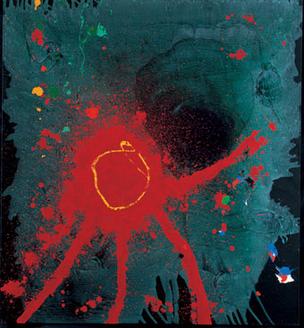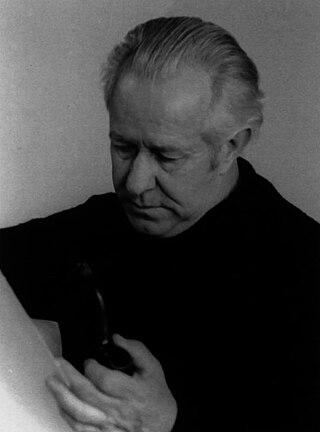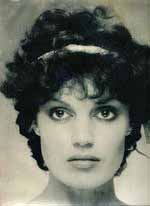
Australian art is any art made in or about Australia, or by Australians overseas, from prehistoric times to the present. This includes Aboriginal, Colonial, Landscape, Atelier, early-twentieth-century painters, print makers, photographers, and sculptors influenced by European modernism, Contemporary art. The visual arts have a long history in Australia, with evidence of Aboriginal art dating back at least 30,000 years. Australia has produced many notable artists of both Western and Indigenous Australian schools, including the late-19th-century Heidelberg School plein air painters, the Antipodeans, the Central Australian Hermannsburg School watercolourists, the Western Desert Art Movement and coeval examples of well-known High modernism and Postmodern art.

George Frederick Henry Bell was an Australian painter and teacher, critic, portraitist, violinist and war artist who contributed significantly to the advancement of the local Modern movement from the 1920s to the 1930s.

The Antipodeans were a group of Australian modern artists who asserted the importance of figurative art, and protested against abstract expressionism. Though they staged but a single exhibition in Melbourne during August 1959, they were noted internationally.

Lyrical abstraction is either of two related but distinct trends in Post-war Modernist painting:
Francis Roderick Kemp AO, OBE,, known as Roger, was one of Australia's foremost practitioners of transcendental abstraction. Kemp developed a system of symbols and motifs which were deployed to develop a method of manifesting creativity at a fundamental level, striving in particular to explain humanities place in a universal order.

Mirka Madeleine Mora was a French-born Australian visual artist and cultural figure who contributed significantly to the development of Australian contemporary art. Her media included drawing, painting, sculpture and mosaic.

Grahame Edwin King was a master Australian printmaker, who has been called the "patron saint of contemporary Australian printmaking". He was responsible for the revival of print making in Australia in the 1960s. He helped set up the Print Council of Australia, of which he was the first Honorary Secretary and was later President. He taught printmaking at The Royal Melbourne Institute of Technology (RMIT) from 1966 to 1988. In 1991, he was awarded an Order of Australia for his services to education. As well as teaching, King produced his own art work, concentrating on lithographs and monotypes. He was also a skilled photographer and used his photography both in his teaching and in his practice.

Wendy Paramor was a mid-20th Century Australian artist. In 2014, the Paramor Prize was created by the Liverpool City Council.
Tate Adams was an Australian artist, based in Townsville, who was named a Member of the Order of Australia in 2009 for service to publishing and to the arts, particularly through contributions to the development of printmaking in Australia. In 2010 he was made the Inaugural Honorary Fellow of the Print Council of Australia.
Peter Bray Gallery was established as Stanley Coe Gallery in 1949 before being renamed in 1951, after a change of management. Situated at 435 Bourke Street, Melbourne, Victoria, Australia, it closed in 1957. Many of the major names in mid-century Australian contemporary art showed there during its brief, but very busy, lifespan.
Sydney Ball was an Australian abstract painter. He has been called ‘one of Australia’s leading colour abstract painters. He has also been credited with bringing large scale abstract expressionist paintings, or Color Field paintings, to Australia.
Dorothy Mary Braund (1926–2013) was an Australian post-war figuration and contemporary feminist artist, whose practice included painting, printmaking and teaching. Braund's extensive career was instrumental in contributing to the Modernist art scene, along with a generation of significant women artists including: Mary Macqueen, Barbara Brash, Anne Marie Graham, Constance Stokes, Anne Montgomery (artist) and Nancy Grant. Braund's first solo exhibition, held in 1952 at Peter Bray Gallery in Melbourne, launched her career and from then on she had consistent shows and exhibitions. Braund has had approximately 29 solo exhibitions and participated in 25 group exhibitions throughout her career. Braund is also a part of the Cruthers Collection of Women's Art.
William Frater (1890–1974) was a Scottish-born Australian stained-glass designer and modernist painter who challenged conservative tastes in Australian art.
Stephen Wickham is an Australian photographer, painter and printmaker.
Ann Thomson is an Australian painter and sculptor. She is best known for her large-scale public commissions Ebb Tide (1987) for the Sydney Convention and Exhibition Centre and Australia Felix (1992) for the Seville World Expo. In 1998 she won the Art Gallery of New South Wales' Wynne Prize. Her work is held in national and international collections, including: the National Gallery of Australia, Canberra; Art Gallery of New South Wales, Sydney, Newcastle Art Gallery, Newcastle, Thyssen-Bornemisza Collection, Madrid and Villa Haiss Museum, Germany.
Gallery A was a mid-century Australian gallery that exhibited contemporary Australian art. It was established in 1959 at 60 Flinders Lane, Melbourne, and then relocated to 275 Toorak Road., South Yarra. A second Gallery A venue was opened and run concurrently at 21 Gipps Street, Paddington in Sydney from 1964, and a third in Canberra. The Sydney business largely displaced the Melbourne gallery, which also closed in 1970, and continued until 1983. Its founder was Max Hutchinson and other directors during the history of the gallery at its three venues included Clement Meadmore, James Mollison, Janet Dawson and Ann Lewis.
Marie Hagerty is an Australian artist, painter, sculptor and teacher.

The Field was the inaugural exhibition at the National Gallery of Victoria’s new premises on St Kilda Road, Melbourne. Launched by the director of London’s Tate gallery, Norman Reid, before an audience of 1,000 invitees, it was held between held 21 August and 28 September 1968. Hailed then, and regarded since as a landmark exhibition in Australian art history, it presented the first comprehensive display of colour field painting and abstract sculpture in the country in a radical presentation, between silver foil–covered walls and under geometric light fittings, of 74 works by 40 artists. All practised hard-edge, geometric, colour and flat abstraction, often in novel media including coloured or transparent plastic, fluorescent acrylic paints, steel and chrome. The art was appropriate to a launch of the new venue itself, designed by architect Roy Grounds, and emphatically rectilinear; cubes nested in a basalt rectangular box amongst the other buildings of the new Arts Centre, each based on a geometric solid. Echoing emerging international stylistic tendencies of the time, The Field sparked immediate controversy and launched the careers of a new generation of Australian artists.
Dawn Sime, who was also known as Dawn Frances Sloggett and Dawn Westbrook, was an abstract painter who was part of the expressionist movement in Melbourne in the late 1950s and 1960s. A pioneer of abstraction at the time, she was among only a few in the field She spent most of her life in Melbourne and died in Castlemaine.

Barbara Nancy Brash was a twentieth-century post-war Australian artist known for her painting and innovative printmaking. In an extensive career she contributed to the Melbourne Modernist art scene, beside other significant women artists including: Mary Macqueen, Dorothy Braund, Anne Marie Graham, Constance Stokes, Anne Montgomery (artist) and Nancy Grant.








